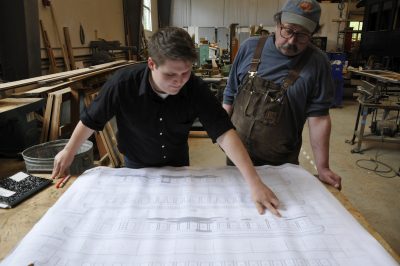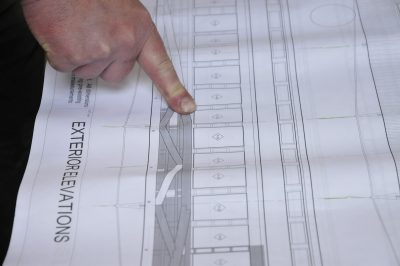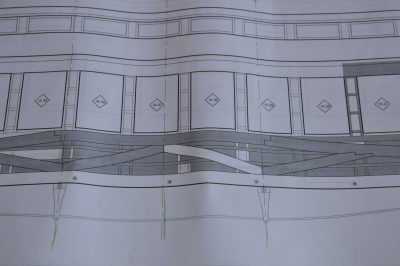
Randy Miller describes his drawing to the project lead rehabilitation specialist Kevin Palo.
Documenting an historic structure is an essential element in any rehabilitation, and is a concomitant of the Secretary of the Interior Standards for the Treatment of Historic Structures. This allows future curators to know what was done, and what the underlying structure looked like without having to take it apart again. The potential value of this information was clear early in the chapel car project when certain parts of the car had to be dismantled to inspect and document because there was no information about the interior structure.

Details are important. Every window, beam and stud are shown. This is an elevation view of the left side of the car.
For the chapel car, the entire structure has been measured. Sketches and photographs have supplemented these dimensions and were used to create a complete set of drawings. AutoCAD is the most popular program used in the architecture and engineering professions and Randy Miller has been creating this thorough documentation that records not only how the car was originally built but what has been repaired or modified during this rehabilitation.

Shaded components indicate new material added to replace damaged or missing structure. The area depicted in this image is in the center of the car on the left-hand side where two doors were cut in the side. The car saw adaptive reuse as a roadside diner, then as a cabana, and finally as a cottage on a Pacific Ocean beach.
Documenting the work is really important. Replacement wood is shown shaded. Notes capture other details such as supplemental supports that may have been installed, or where replacement steel or iron was incorporated. Missing features discovered during research are also added and identified on the drawing as restoration. The final product stands as a record not just of the chapel car but of wood cars produced by Barney and Smith circa 1898. Good work Randy, and thanks to Save America’s Treasures for funding this important part of the project!





Spike, True dedication! That's what it takes to ensure that any preservation project is done right. Your group must be congratulated on their overall efforts… Take Care, Big Daddy Dave